
|
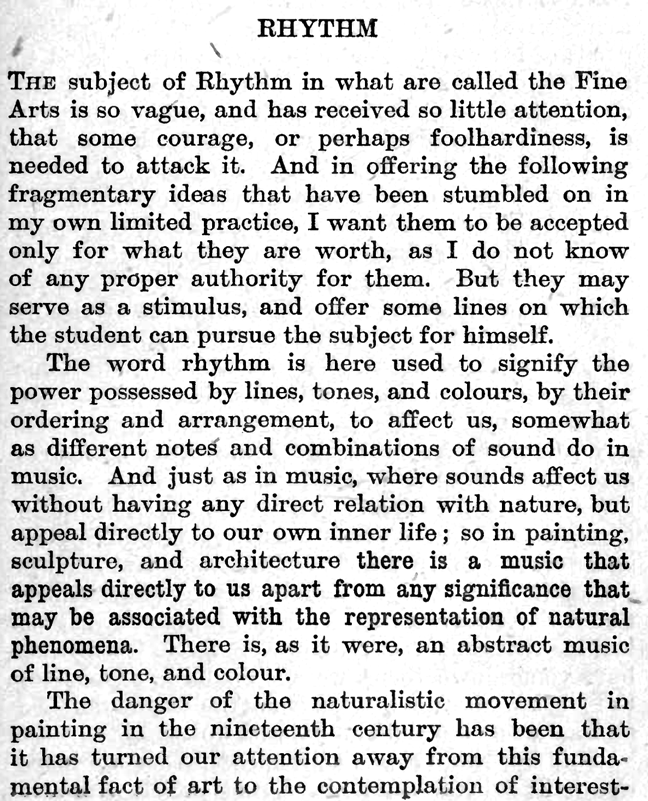
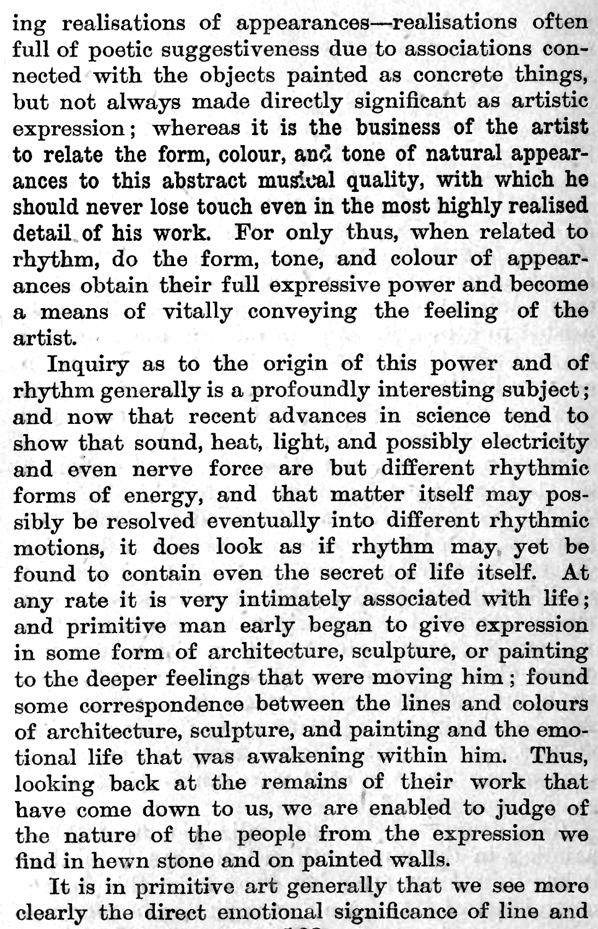
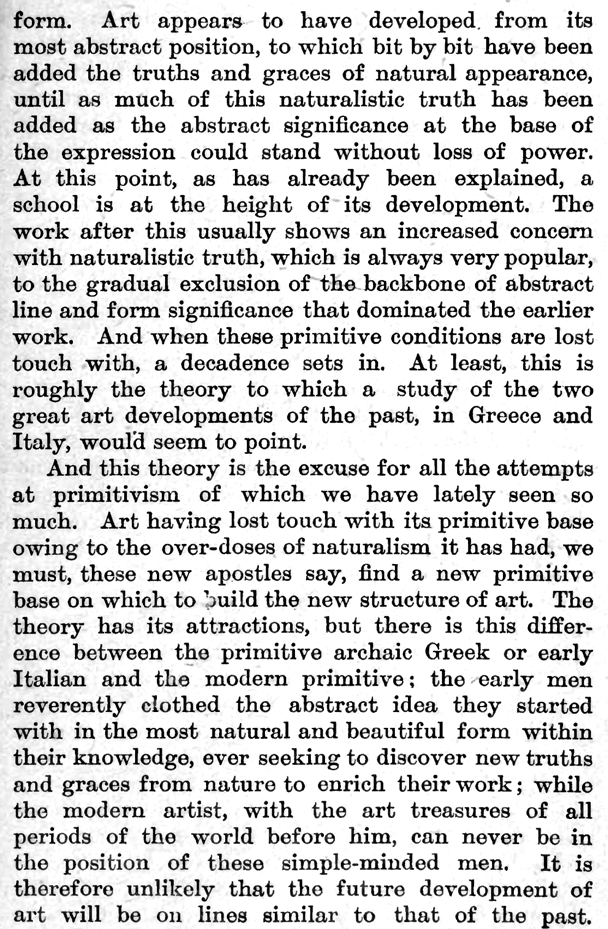
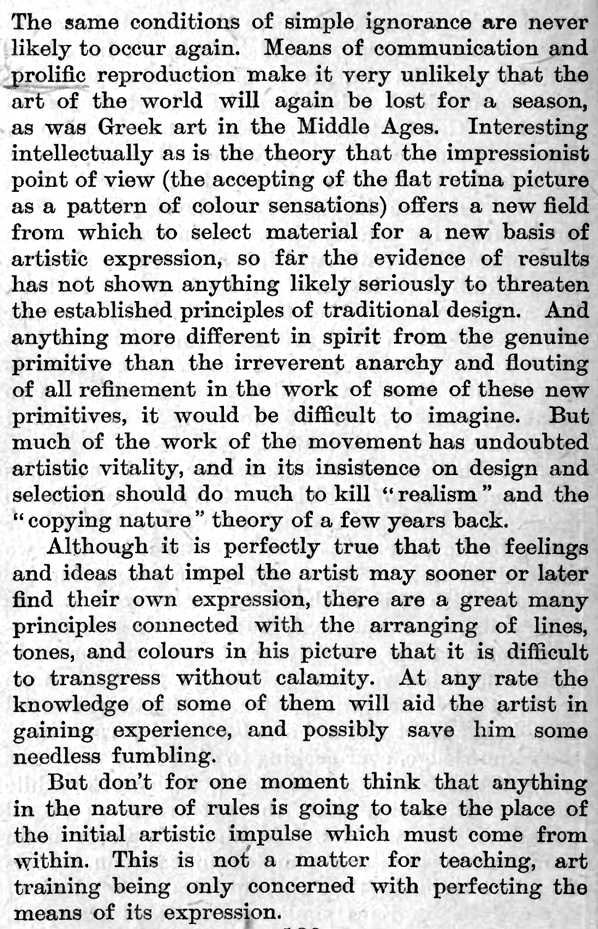
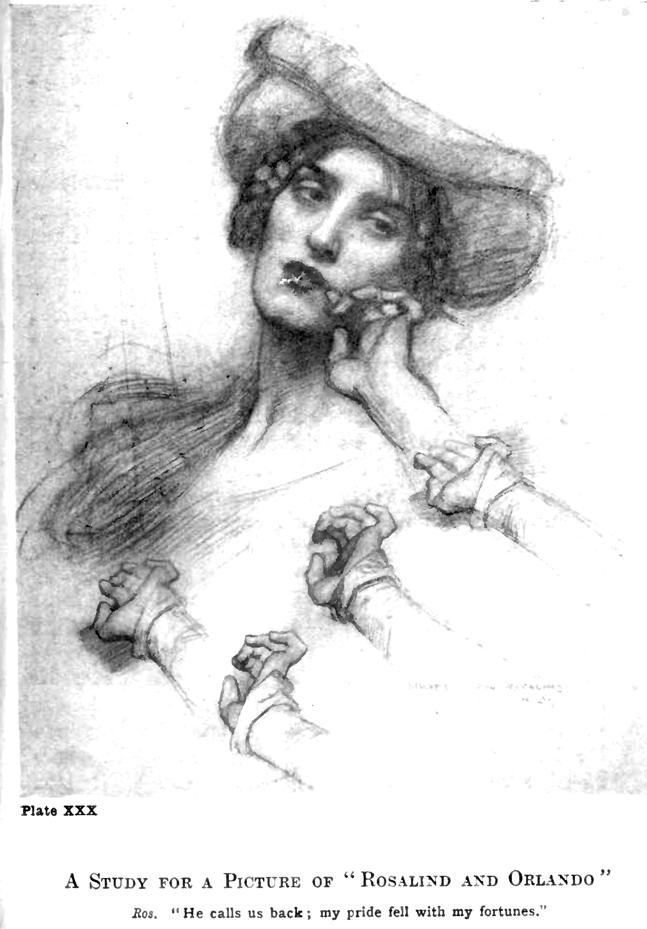
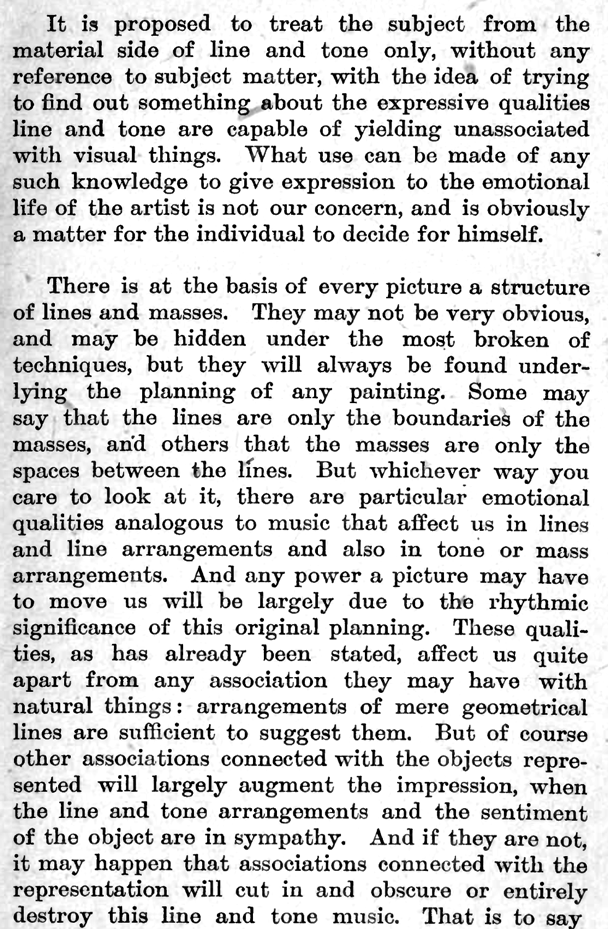
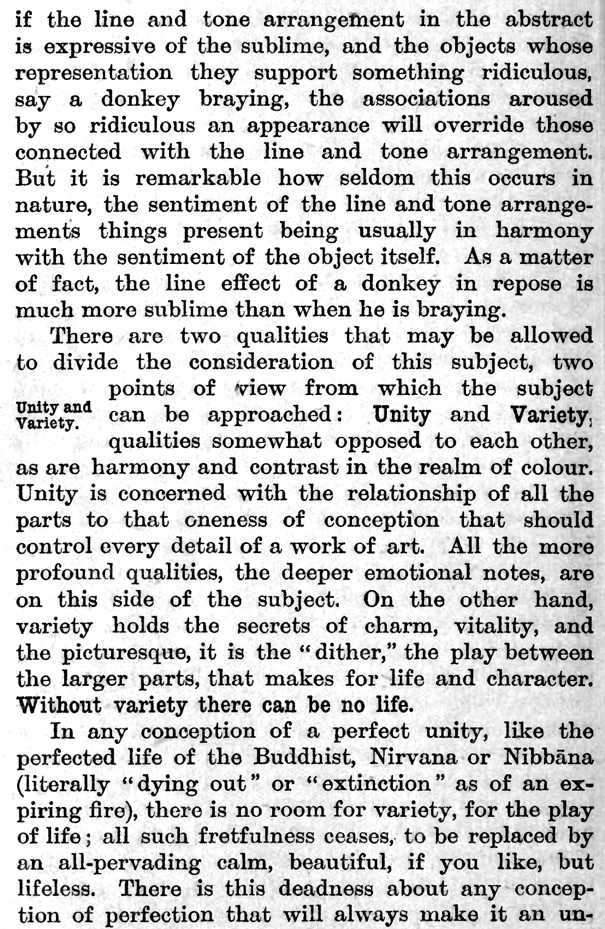
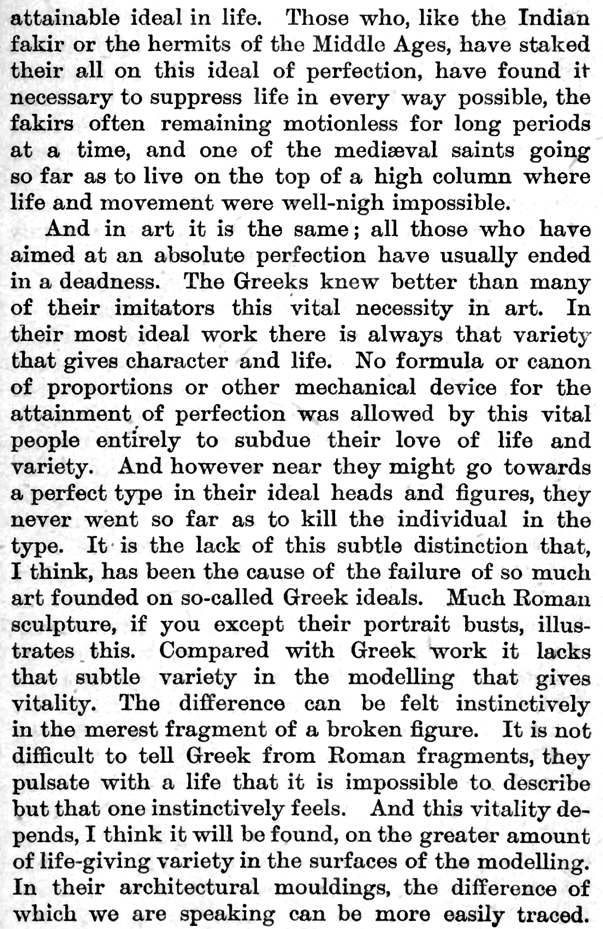
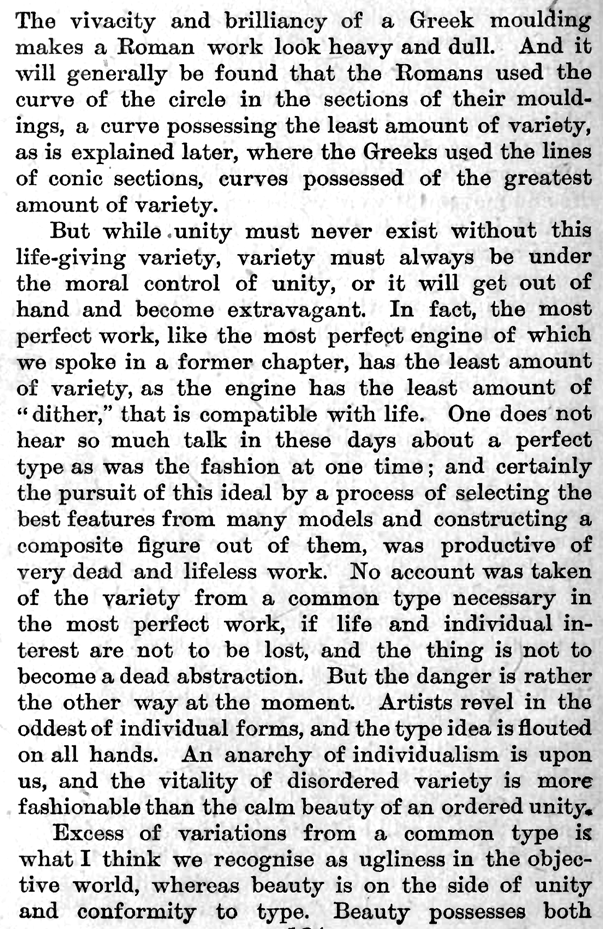
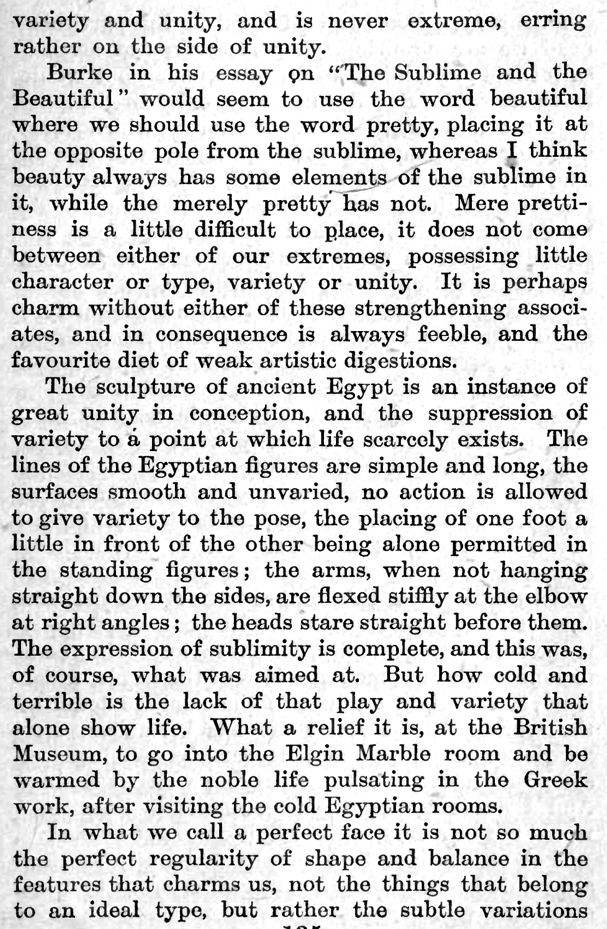
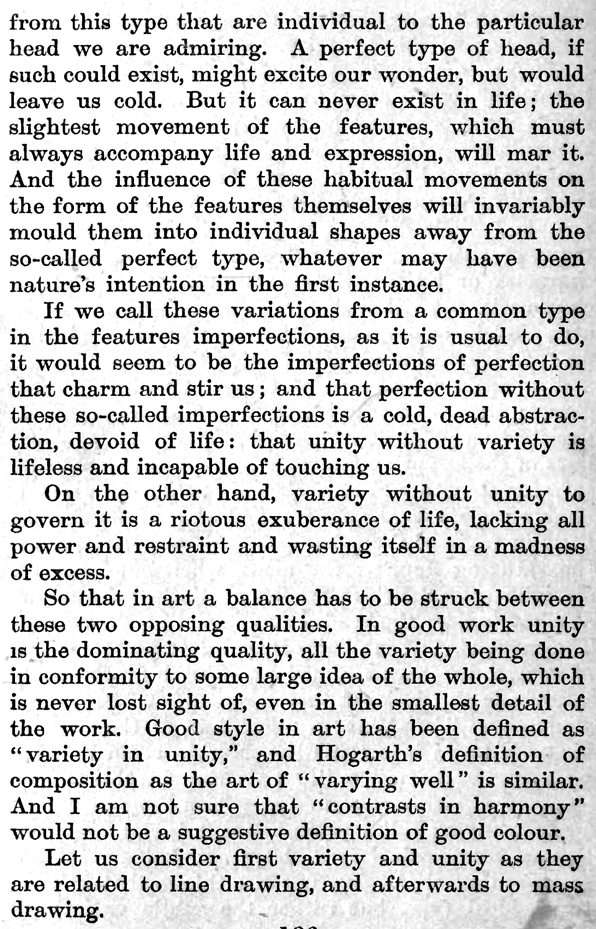
If your some reason you need the actual text for the images above...you can find it below
RHYTHM
The subject of Rhythm in what are called the Fine Arts is so vague, and has received so little attention, that some courage, or perhaps foolhardiness, is needed to attack it. And in offering the following fragmentary ideas that have been stumbled on in my own limited practice, I want them to be accepted only for what they are worth, as I do not know of any proper authority for them. But they may serve as a stimulus, and offer some lines on which the student can pursue the subject for himself.
The word rhythm is here used to signify the power possessed by lines, tones, and colors, by their ordering and arrangement, to affect us, somewhat as different notes and combinations of sound do in music. And just as in music, where sounds affect us without having any direct relation with nature, but appeal directly to our own inner life ; so in painting, sculpture, and architecture there is a music that appeals directly to us apart from any significance that may be associated with the representation of natural phenomena. There is, as it were, an abstract music of line, tone, and color.
The danger of the naturalistic movement in painting in the nineteenth century has been that it has turned our attention away from this fundamental fact of art to the contemplation of interest-
ing realizations of appearances—realizations often full of poetic suggestiveness due to associations connected with the objects painted as concrete things, but not always made directly significant as artistic expression ; whereas it is the business of the artist to relate the form, color., and tone of natural appearances to this abstract muse quality, with which he should never lose touch even in the most highly realized detail of his work. For only thus, when related to rhythm, do the form, tone, and color. of appearances obtain their full expressive power and become a means of vitally conveying the feeling of the artist.
Inquiry as to the origin of this power and of rhythm generally is a profoundly interesting subject; and now that recent advances in science tend to show that sound, heat, light, and possibly electricity and even nerve force are but different rhythmic forms of energy, and that matter itself may possibly be resolved eventually into different rhythmic motions, it does look as if rhythm may yet be found to contain even the secret of life itself. At any rate it is very intimately associated with life ; and primitive man early began to give expression in some form of architecture, sculpture, or painting to the deeper feelings that were moving him ; found some correspondence between the lines and colors of architecture, sculpture, and painting and the emotional life that was awakening within him. Thus, looking back at the remains of their work that have come down to us, we are enabled to judge of the nature of the people from the expression we find in hewn stone and on painted walls.
It is in primitive art generally that we see more clearly the direct emotional significance of line and
form. Art appears to have developed, from its most abstract position, to which bit by bit have been added the truths and graces of natural appearance, until as much of this naturalistic truth has been added as the abstract significance at the base of the expression could stand without loss of power. At this point, as has already been explained, a school is at the height of its development. The work after this usually shows an increased concern with naturalistic truth, which is always very popular, to the gradual exclusion of the backbone of abstract line and form significance that dominated the earlier work. And when these primitive conditions are lost touch with, a decadence sets in. At least, this is roughly the theory to which a study of the two great art developments of the past, in Greece and Italy, would seem to point.
And this theory is the excuse for all the attempts at primitivism of which we have lately seen so much. Art having lost touch with its primitive base owing to the over-doses of naturalism it has had, we must, these new apostles say, find a new primitive base on which to build the new structure of art. The theory has its attractions, but there is this difference between the primitive archaic Greek or early Italian and the modern primitive ; the early men reverently clothed the abstract idea they started with in the most natural and beautiful form within their knowledge, ever seeking to discover new truths and graces from nature to enrich their work ; while the modern artist, with the art treasures of all periods of the world before him, can never be in the position of these simple-minded men. It is therefore unlikely that the future development of art will be on lines similar to that of the past.
The same conditions of simple ignorance are never likely to occur again. Means of communication and prolific reproduction make it very unlikely that the art of the world will again be lost for a season, as was Greek art in the Middle Ages. Interesting intellectually as is the theory that the impressionist point of view (the accepting of the flat retina picture as a pattern of color. sensations) offers a new field from which to select material for a new basis of artistic expression, so far the evidence of results has not shown anything likely seriously to threaten the established principles of traditional design. And anything more different in spirit from the genuine primitive than the irreverent anarchy and flouting of all refinement in the work of some of these new primitives, it would be difficult to imagine. But much of the work of the movement has undoubted artistic vitality, and in its insistence on design and selection should do much to kill " realism " and the " copying nature " theory of a few years back.
Although it is perfectly true that the feelings and ideas that impel the artist may sooner or later find their own expression, there are a great many principles connected with the arranging of lines, tones, and colors in his picture that it is difficult to transgress without calamity. At any rate the knowledge of some of them will aid the artist in gaining experience, and possibly save him some needless fumbling.
But don't for one moment think that anything in the nature of rules is going to take the place of the initial artistic impulse which must come from within. This is not a matter for teaching, art training being only concerned with perfecting the means of its expression.
Plate XXX
A STUDY FOR A PICTURE OF " ROSALIND AND ORLANDO "
It is proposed to treat the subject from the material side of line and tone only, without any reference to subject matter, with the idea of trying to find out something about the expressive qualities line and tone are capable of yielding unassociated with visual things. What use can be made of any such knowledge to give expression to the emotional life of the artist is not our concern, and is obviously a matter for the individual to decide for himself.
There is at the basis of every picture a structure of lines and masses. They may not be very obvious, and may be hidden under the most broken of techniques, but they will always be found underlying the planning of any painting. Some may say that the lines are only the boundaries of the masses, and others that the masses are only the spaces between the lines. But whichever way you care to look at it, there are particular emotional qualities analogous to music that affect us in lines and line arrangements and also in tone or mass arrangements. And any power a picture may have to move us will be largely due to the rhythmic significance of this original planning. These qualities, as has already been stated, affect us quite apart from any association they may have with natural things : arrangements of mere geometrical lines are sufficient to suggest them. But of course other associations connected with the objects represented will largely augment the impression, when the line and tone arrangements and the sentiment of the object are in sympathy. And if they are not, it may happen that associations connected with the representation will cut in and obscure or entirely destroy this line and tone music. That is to say
if the line and tone arrangement in the abstract is expressive of the sublime, and the objects whose representation they support something ridiculous, say a donkey braying, the associations aroused by so ridiculous an appearance will override those connected with the line and tone arrangement. But it is remarkable how seldom this occurs in nature, the sentiment of the line and tone arrangements things present being usually in harmony with the sentiment of the object itself. As a matter of fact, the line effect of a donkey in repose is much more sublime than when he is braying.
There are two qualities that may be allowed to divide the consideration of this subject, two
qualities somewhat opposed to each other, as are harmony and contrast in the realm of color. Unity is concerned with the relationship of all the parts to that oneness of conception that should control every detail of a work of art. All the more profound qualities, the deeper emotional notes, are on this side of the subject. On the other hand, variety holds the secrets of charm, vitality, and the picturesque, it is the " dither," the play between the larger parts, that makes for life and character. Without variety there can be no life.
In any conception of a perfect unity, like the perfected life of the Buddhist, Nirvana or Nibbana (literally " dying out" or " extinction " as of an expiring fire), there is no room for variety, for the play of life ; all such fretfulness ceases, to be replaced by an all-pervading calm, beautiful, if you like, but lifeless. There is this deadness about any conception of perfection that will always make it an un
attainable ideal in life. Those who, like the Indian fakir or the hermits of the Middle Ages, have staked their all on this ideal of perfection, have found it necessary to suppress life in every way possible, the fakirs often remaining motionless for long periods at a time, and one of the mediaeval saints going so far as to live on the top of a high column where life and movement were well-nigh impossible.
And in art it is the same ; all those who have aimed at an absolute perfection have usually ended in a deadness. The Greeks knew better than many of their imitators this vital necessity in art. In their most ideal work there is always that variety that gives character and life. No formula or canon of proportions or other mechanical device for the attainment of perfection was allowed by this vital people entirely to subdue their love of life and variety. And however near they might go towards a perfect type in their ideal heads and figures, they never went so far as to kill the individual in the type. It is the lack of this subtle distinction that, I think, has been the cause of the failure of so much art founded on so-called Greek ideals. Much Roman sculpture, if you except their portrait busts, illustrates this. Compared with Greek work it lacks that subtle variety in the modeling that gives vitality. The difference can be felt instinctively in the merest fragment of a broken figure. It is not difficult to tell Greek from Roman fragments, they pulsate with a life that it is impossible to describe but that one instinctively feels. And this vitality depends, I think it will be found, on the greater amount of life-giving variety in the surfaces of the modeling In their architectural moldings, the difference of which we are speaking can be more easily traced.
Burke in his essay on "The Sublime and the Beautiful " would seem to use the word beautiful where we should use the word pretty, placing it at the opposite pole from the sublime, whereas I think beauty always has some elements of the sublime in it, while the merely pretty has not. Mere prettiness is a little difficult to place, it does not come between either of our extremes, possessing little character or type, variety or unity. It is perhaps charm without either of these strengthening associates, and in consequence is always feeble, and the favorite diet of weak artistic digestions.
The sculpture of ancient Egypt is an instance of great unity in conception, and the suppression of variety to a point at which life scarcely exists. The lines of the Egyptian figures are simple and long, the surfaces smooth and unvaried, no action is allowed to give variety to the pose, the placing of one foot a little in front of the other being alone permitted in the standing figures ; the arms, when not hanging straight down the sides, are flexed stiffly at the elbow at right angles ; the heads stare straight before them. The expression of sublimity is complete, and this was, of course, what was aimed at. But how cold and terrible is the lack of that play and variety that alone show life. What a relief it is, at the British Museum, to go into the Elgin Marble room and be warmed by the noble life pulsating in the Greek work, after visiting the cold Egyptian rooms.
In what we call a perfect face it is not so much the perfect regularity of shape and balance in the features that charms us, not the things that belong to an ideal type, but rather the subtle variations
from this type that are individual to the particular head we are admiring. A perfect type of head, if such could exist, might excite our wonder, but would leave us cold. But it can never exist in life ; the slightest movement of the features, which must always accompany life and expression, will mar it. And the influence of these habitual movements on the form of the features themselves will invariably mould them into individual shapes away from the so-called perfect type, whatever may have been nature's intention in the first instance.
If we call these variations from a common type in the features imperfections, as it is usual to do, it would seem to be the imperfections of perfection that charm and stir us ; and that perfection without these so-called imperfections is a cold, dead abstraction, devoid of life : that unity without variety is lifeless and incapable of touching us.
On the other hand, variety without unity to govern it is a riotous exuberance of life, lacking all power and restraint and wasting itself in a madness of excess.
So that in art a balance has to be struck between these two opposing qualities. In good work unity is the dominating quality, all the variety being done in conformity to some large idea of the whole, which is never lost sight of, even in the smallest detail of the work. Good style in art has been defined as " variety in unity," and Hogarth's definition of composition as the art of " varying well" is similar. And I am not sure that " contrasts in harmony" would not be a suggestive definition of good color.
Let us consider first variety and unity as they are related to line drawing, and afterwards to mass drawing.
|















